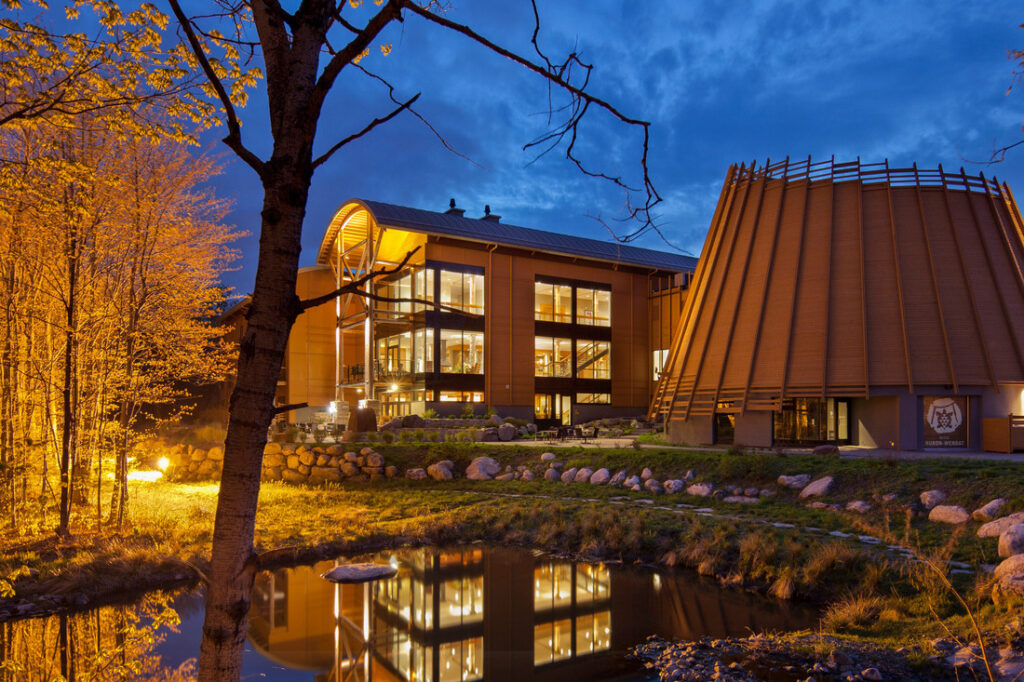This year, many states have opted to honor Indigenous Peoples’ Day over the problematic Columbus Day. These destinations offer visitors an authentic way to experience other cultures and leave the holiday weekend with an open mind and fascinating stories to share.
1. Hôtel-Musée Premières Nations — Wendake, Quebec, Canada
This boutique hotel, combined with a museum and restaurant (La Traite), is operated by the Wendat people less than 10 miles outside Quebec City. The modern museum shares the creation story and history of the Wendat Nation and offers a guided tour exploring an Ekionkiestha longhouse (a dwelling of the Iroquoian peoples) and a small historic church that marries First Nations and traditional Catholic elements.
Adventurous types can even spend the night in the longhouse; a firekeeper will attend to the fire throughout the night. Luxurious backup rooms with views of the Akiawenrahk River await in the adjacent hotel. Don’t miss the nearby Onhwa’ Lumina night walk through the forests, with multimedia vignettes illuminating the story of the local people.
One of the most memorable aspects of a visit to Wendake is sampling the talents of Chef Anora Lia Collier (Wolf clan) at La Traite. The granddaughter of a grand chief, Collier creates Wendat delicacies such as deer heart, elk filet mignon, morel mushrooms and fir-juice glazed wild guinea fowl, served with sweet grass emulsions and sauces of clover, Labrador tea and dune pepper.
2. La Posada and Homolovi Archaeology Site — Winslow/Navajo County, Arizona
Get your kicks—and a dose of indigenous history—on Route 66 at the Homolovi State Park. Scenic Tsu’vö Trail (“path of the rattlesnake” in Hopi) offers observant early-light trekkers a glimpse of milling stone areas and petroglyphs. The Homolovi II trail provides access to archaeological sites containing many rooms—estimated to be in the thousands. These pueblos were once home to ancestral Hopi. The sides of the trail are littered with shards of 14th-century pottery, still bearing striking painted designs.
Camp on-site or stay at La Posada in nearby Winslow, Arizona (made famous in the Eagles’ song “Take it Easy”). La Posada owners opened the Affeldt Mion Museum, where the largest-known hand-spun Navajo rug is on display. To get a true taste of the local Hopi culture and eats, try piki bread— painstakingly made on the local reservation by spreading ground corn paste mixed with culinary ash across a sandstone slab baked in the desert sun. When dry, the bread is peeled from the rock in paper-thin layers and hand-rolled into scrolls. These can be dipped in hummus.
3. Tiki Immerges De Papetoai and Kia Ora Resort — Moorea, French Polynesia
The art of Indigenous people can be found in unusual locales. A 1998 submerged tiki exhibit in Moorea is the work of local artist, Tihoti GUY. Each of the 4-to-6-foot tall tikis was hand-carved from volcanic stone and placed on the seabed. Visitors can kayak or snorkel to view the collection in the clear warm waters of Papetoai. The exhibit was designed to honor the sacrifice of the Indigenous people, who were compelled by foreign missionaries to abandon their heritage and cast all of their religious idols into the sea.
This experience can be reached from Softitel Kia Ora Moorea, a modern luxury property, though nods to authentic Polynesian culture abound. Guests will enjoy a warm lei greeting, a Polynesian Taurumi massage or a gourmet breakfast delivered by traditional outrigger canoe. Local Kahaia wood forms the soaring cathedral ceiling of the main dining room, where sustainably caught lagoon fish is cooked in an ahi ma’a oven and eaten while listening to a ukulele trio.
4. Skwachays Lodge and Salmon ‘n Bannock — Vancouver, Canada
Vancouver has the third-largest urban Indigenous population in Canada, with over 52,000 individuals. In the heart of downtown, flanked by skyscrapers and topped by a somewhat incongruous massive totem pole, is a four-story social enterprise called Skwachàys Lodge. The lodge combines a stylish boutique hotel with on-site housing and studio space for 24 Indigenous artists. The work of these artists also decorates the four-star hotel’s individual rooms.
Work up an appetite paddling a 35-foot traditional ocean-going canoe through the Indian Arm with Takaya Tours, while guides sing ancient songs and share stories of their people. Pemmican mousse is a favorite dish at Salmon n’ Bannock restaurant. The savory delight made of smoked and dried bison, mixed with sage-infused blueberries and cream cheese makes the perfect accompaniment to seasonal game sausage or candied salmon, served with a drizzle of maple.
5. Alcatraz and Cavallo Point — San Francisco, California
Alcatraz doesn’t scream “indigenous travel,” which was the point of “Indians of All Tribes,” a group of native activists who took over the island to reclaim their heritage land in 1969. Their 19-month-long occupation of the former federal penitentiary served as a watershed moment in the Native American rights movement.
An exhibit created in collaboration with the counsel for the Indians of All Tribes, the Golden Gate National Recreation Area, the Golden Gate Parks Conservancy, and Alcatraz Island includes memorabilia from the occupation in addition to a film featuring the perspectives of those involved in the protest. Visitors are welcome to share their experiences, yielding fascinating notes left by those present at the time. A massive photography exhibit brings the event to life and highlights the island’s history of incarcerating 19 Hopi elders for nearly a year for protesting the forced separation of Native children into boarding schools and the U.S. government’s termination policy.
Enjoy the beauty of Alcatraz Island and the once-Miwok-held Angel Islands like the San Francisco Bay Indigenous people did. Originally inhabited for 2,000 years by the coastal Miwok tribes, Horseshoe Cove sits at the far end of the Golden Gate Bridge. This flat stretch of land overlooking the skyline became an army fort before those same buildings were renovated into the charming, luxury lodge of Cavallo Point — named for the wild stallions which once roamed the property. A relaxing meal on the porch of Sula restaurant at the lodge is the perfect spot to enjoy the sweeping views.
Photo of Hôtel-Musée Premières Nations courtesy of Stephane Groleau





